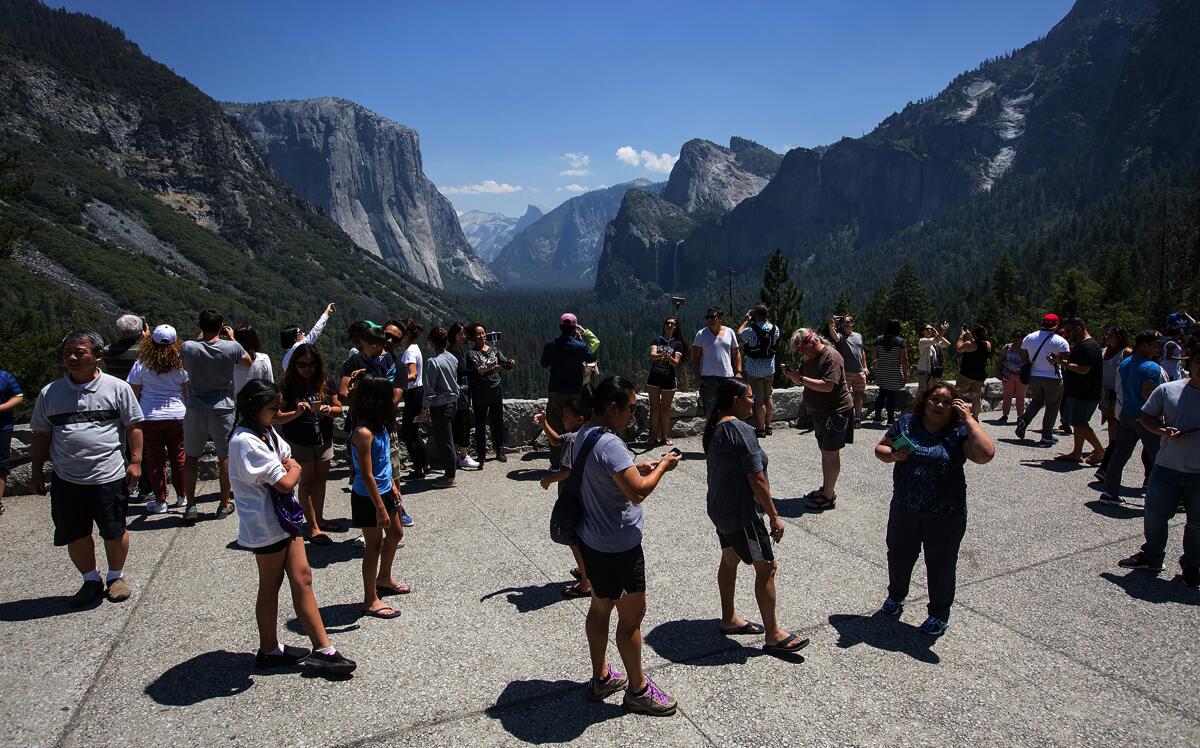Op-Ed: Yosemite has been at its best under pandemic restrictions. Keep the cap on crowds

- Share via
My career with the National Park Service started in 1976 with a gig as a seasonal backcountry ranger at Yosemite National Park, one of the busiest parks in the country. That year, we welcomed around 2.7 million visitors. As I look back, it’s clear we didn’t know what “busy” meant. By 2019, the number of visitors had grown by more than 60%, to a record 4.4 million.
After serving 34 years at Yosemite and later as the superintendent of Joshua Tree National Park, I’ve had a front-row seat as California’s national parks have exploded in popularity to become truly world-famous tourist destinations. That’s wonderful — but the flood of visitors brings a host of problems.
As it happens, the past two summers have presented a solution. To curb crowding during the pandemic, Yosemite used a reservation system during peak season to cap the number of vehicles in the park at a given time. Depending on COVID transmission rates, attendance in 2021 has been limited to 60-90% of 2019 levels. As of September, Yosemite had received 2.8 million visitors this year. By the same point in 2019, the figure was 3.8 million.
Many of the people who visited during the reservation period — myself included — said it was their most enjoyable park visit in years. That tells you something about the issues crowding had created before the pandemic hit.
At more than 750,000 acres, Yosemite is the third-largest park in California, behind Death Valley and Joshua Tree. Despite its sprawl, visitors often stick to the same few best-known trails and viewpoints, battle for spaces in the same parking lots, and take the same single-lane roads into Yosemite Valley, the heart of the park.
These small choke points can create big problems. Visitors can get stuck in hours-long traffic jams, and lines for restaurants, bathrooms and visitor centers seem longer than ever, while trails and vista points are crowded with people struggling to get the same photograph.
The same visitors who come to parks to get away from the bustle of the city can find themselves in an even busier environment than the one they left. When the National Parks Conservation Assn. asked its supporters about overcrowding, more than 80% of respondents had experienced overcrowding in parks and changed their plans because of it. Overcrowding takes its toll on the park too, as roads, trails and other facilities degrade more quickly.
Other parks have enacted approaches like Yosemite’s temporary one. A similar system is permanently in place at Muir Woods in Northern California, and admission to Alcatraz has always been dependent on getting a ticket for the boat ride to the island. Rocky Mountain National Park successfully tested a reservation system this summer, while Acadia and Glacier national parks required bookings for their most overcrowded spots.
My own trips back to Yosemite using the reservation system reminded me of the park decades earlier. With reduced traffic, getting into the park was simple. The trails were not congested, so you could more easily see and appreciate the park’s natural beauty. It was a better experience — and one that we could make normal again.
A reservation system would not be necessary all year but could be helpful during predictably busy periods. This Easter — before the summer reservation season began — some visitors were stuck in traffic for three hours in Yosemite Valley. That’s nobody’s idea of a good park trip. Capping visits during the busiest periods would incentivize people to visit at less crowded times and spread the number of visitors more evenly throughout the year.
Reservation systems rushed into place to respond to a public health emergency will naturally need refinement. For instance, Yosemite reservations had to be made through an English-only website, creating hurdles for many potential visitors. Park managers know that national parks should be for everyone, and they did an excellent job given the circumstances. Now is the chance to smooth out some of the initial problems.
No one wants visitors turned away at the gate, so the need for a reservation should be publicized widely. The park could also hold back some passes for day-of and week-of bookings, to keep alive the possibility of spontaneous road trips to Yosemite.
National parks are supported by a booming network of small businesses that provide beds for the night, places to eat, guided tours and outdoor equipment, and it will be important to ensure that this community is consulted as well. Any permanent reservation system should be crafted to prevent or minimize harm to these businesses.
As park managers, we strive to protect the park and provide the best experience for visitors. If a reservation system during peak seasons gets us closer to that goal, then we should make it permanent and ensure Yosemite remains a natural treasure that we can all enjoy.
Mark Butler is the former superintendent of Joshua Tree National Park and was chief of project management at Yosemite National Park.
More to Read
A cure for the common opinion
Get thought-provoking perspectives with our weekly newsletter.
You may occasionally receive promotional content from the Los Angeles Times.










